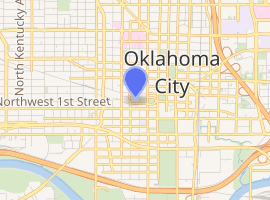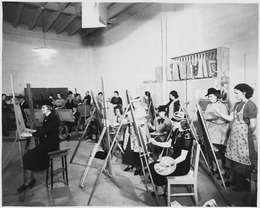Civic Center Music Hall
The Civic Center Music Hall is a performing arts center located in Oklahoma City, Oklahoma. It was constructed in 1937 as Municipal Auditorium and renamed in 1966. The facility includes the Thelma Gaylord Performing Arts Theatre, the Freede Little Theatre, CitySpace, the Meinders Hall of Mirrors and the Joel Levine Rehearsal Hall.
 | |
 | |

| |
| Address | 201 North Walker Ave. Oklahoma City, Oklahoma United States |
|---|---|
| Coordinates | 35.469041°N 97.523361°W |
| Type | Performing arts center |
| Capacity | Thelma Gaylord Performing Arts Theatre: 2,477 Freede Little Theatre: 286 CitySpace Theatre: 100 |
| Construction | |
| Opened | October 4, 1937 |
| Architect | Hawk & Parr |
| Website | |
| www | |
The Civic Center Music Hall is managed and operated in conjunction with the Rose State Performing Arts Theatre. Together they serve more than 300,00 patrons at around 250 performances at six different stages each year. The center is home to eight professional arts organizations: Black Liberated Arts Center, Canterbury Choral Society, Nederlander, Lyric Theatre and Academy, Oklahoma City Ballet, Oklahoma City Philharmonic, Oklahoma City Repertory Theatre, and Oklahoma City Theatre Company.[1]


History
In 1927, the Oklahoma City Chamber of Commerce and the city jointly purchased the land that would become home to a municipal auditorium after voters approved a $4 million bond for the site. President Franklin D. Roosevelt's New Deal programs in the 1930s contributed 55 percent of the cost of building through the Public Works Administration. J. O. Parr began planning and designing the Municipal Auditorium, budgeted at $1.25 million. The original design features a six-story building with both neoclassical and Art Deco features that seated 6,200 in the main hall and smaller theatre that seated 400.
In August 1935, the Roosevelt Administration announced that all PWA projects had to break ground by December 1935 or risk losing federal support. W. S. Bellows Construction became the primary contractor and began on-site excavation on time. The Municipal Auditorium was completed in April 1937. The first performance, "Rhapsodic Rhythms" took place on October 4, 1937.
The Oklahoma Art Center, a community art center administered by the Federal Art Project, was located in Municipal Auditorium.[2] Fundraising campaigns began for the successful organization as the Federal Art Project came to an end, and in May 1945 the Oklahoma Art Center was incorporated.[3] In 1989 it was merged into the Oklahoma City Museum of Art.[4]
In 1966, the Municipal Auditorium was remodeled and renamed the Civic Center Music Hall.[5] The main auditorium was renovated to cater more to the performing arts by decreasing the size of the hall, moving the side wall in and installing mahogany panels, lowering the ceiling and replacing the portable floor with a sloped fixed floor. In 1971, the basement was converted into office space and later converted back to the theatre space and dressing rooms. One of the biggest concerts to ever play the venue was KISS on their 1976 Alive! tour. The band's opening act did not make it to the building forcing the management to find a new opening act on the day of the show. The band that was called to fill in was referred by the then Assistant Technical Director Richard Charnay (who would put in a 40+ year career at the music hall). The band was called Mountain Smoke which featured an unknown artist by the name of Vince Gill.
The Little Theatre was closed in 1985 because it was damaged from old age, abuse, and a fire. It was later renovated and reopened to the public.
In September 2001, the Civic Center Music Hall reopened after a three-year renovation. A complete interior renovation of the historic Civic Center Music Hall includes accommodations for major theatrical, dance and musical groups; a multi-story atrium; balconies, box seats and suites; excellent acoustics; and a hydraulic orchestra pit.
The building was listed on the National Register of Historic Places in 2016.
Foundation and volunteer organizations
The Civic Center Foundation, established in 2001, is a private non-profit organization that supports the Civic Center Music Hall financially to help bring performing arts to Oklahoma City to improve the community.[6]
The Civic Center Foundation has helped make capital improvements including the Civic Center Music Hall's new message center and improvements to the Freede Little Theatre.
The foundation raises funds through two programs, the Seat Back Campaign and the Suite Holder Program.[6] Patrons can help the Civic Center Music Hall by purchasing personalized seat back plates at the Thelma Gaylord Performing Arts Theatre or by becoming a suite or box holder at the Civic Center Music Hall.
The Civic Center Music Hall is also home to STARS, a volunteer group of more than 300 people who contribute thousands of hours each year.[7]
See also
- National Register of Historic Places listings in Oklahoma County, Oklahoma
- The Conductor (sculpture), installed outside the hall
References
- Resident Companies (accessed May 19, 2010).
- "The Works Progress Administration". Oklahoma Historical Society. Archived from the original on 2015-06-20. Retrieved 2015-06-20.
- "Oklahoma City Museum of Art". Resource Library. Traditional Fine Arts Organization, Inc. 2009. Retrieved 2015-06-20.
- "Museum History". Oklahoma City Museum of Art. Archived from the original on 2015-07-22. Retrieved 2015-06-20.
- Civic Center Music Hall Profile, About.com (accessed May 19, 2010).
- Civic Center Foundation (accessed May 19, 2010).
- Civic Center Volunteers (STARS) (accessed May 19, 2010).
External links
| Wikimedia Commons has media related to Civic Center Music Hall. |